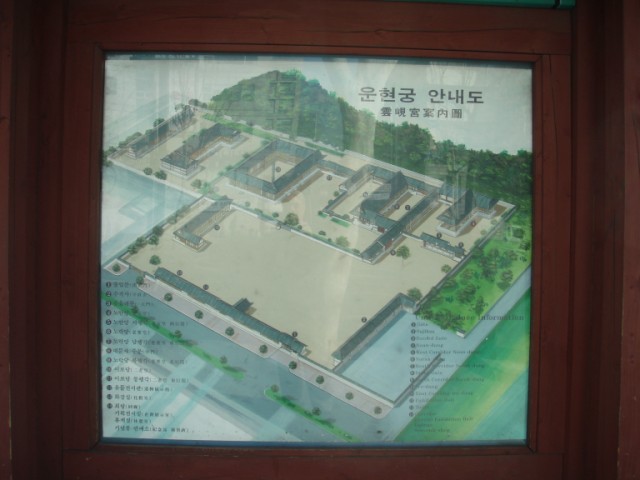
Text of Marker:
UNHYEONGUNG
Designation: Historic Site No. 257
Period: Jeoson Dynasty, 1863
Location: 98-59 Unni-dong, Jongno-gu, Seoul
Unhyeongung was the residence of Emprorer Gojong's father, Yi Haeung, better known as Heungseon Daewongun, and it was also where Gojong grew up before he ascended the throne at the age of 11. It was named Unhyeongung after a nearby hill on December 9, 1863, after Gojang ascended the throne.
One month after Gojang ascended the throne, Unhyeongung undewent major expansion at the order of Queen Mother Cho, and buildings such as Norakdang and Noandong were built at this time. It is believed that the Kim Seunghyeon House and Yuksadang, which lie to the west of Unhyeongung in Unni-dong and have been designated Seoul Folklore Material No. 19, were also part of Unhyeongung.
From the Wikipedia
Unhyeon Palace is a former Korean royal residence located at 114-10 Unni-dong, Jongno-gu, Seoul, Korea. It was formerly the residence of Prince Regent Daewon-gun, ruler of Korea during the Joseon Dynasty in the 19th century, and father of King Gojong. Gojong himself also lived in this palace until age 12 when he assumed the throne. The residence is open to the public; an admission fee is charged.
The site dates from the 1300s.
Most early buildings were damaged or destroyed over the years, but some of the early construction remains. Under the direction of Queen Mother Jo, Unhyeongung was converted into a grander complex with four gates. Although the residential complex was taken from Daewon-gun's descendents under Japanese colonial rule, it was returned in 1948, and in 1993 they sold it to the Seoul government. It subsequently underwent 3 years of renovations to restore its earlier appearance. Today's complex is smaller than its previous extent, as Duksung Women's University now occupies part of its grounds.
The remaining complex includes:
Noan-dang Hall - Residence and working area for Prince Regent Hungson Taewongun. Women were not allowed in this area.
Norak-dang Hall - Largest building within the complex, and wedding site of King Gojong and Queen Min.
Iro-dang Hall - Women's residence.
Sujik-sa - Servants' quarters.
Some of the interiors have been refurnished, and contain mannequins dressed in typical clothing styles for various stations of life in Korean history. The complex also contains a small museum.
Unhyeongung

Unhyeongung (small palace) was the home of young Gojong who later became Emperor in the Joseon Dynasty. Under the orders of Queen Mother Jo, Unhyeongung (small palace) was renovated into a grand palace-like house with four gates. Gojong’s father, Yi Haeung, or better known as Heungseon Daewongun, continued to live at Unhyeongung (small palace). Damaged during the Japanese colonial period and the Korean War, the Unhyeongung (small palace) seen today is a much smaller version of the majestic structure that it used to be.
Entering the front gate, the first noticeable structure is a small row of rooms to the right. This structure, called Sujiksa, housed the servants and guards. A little bit to the front and left of Sujiksa, there is a structure called Norakdang. Many important events such as birthday parties, ceremonies, as well as the wedding ceremony for Gojong and Myeongseong were held here. To this day, traditional wedding ceremonies are still held at Norakdang. Norakdang also served as one of the two women’s quarters. The most notable structure inside Norakdang is the kitchen, which was most likely used for food preparation when hosting important events. Right outside Norakdang, there are several rock structures along the path to Irodang. Supposedly, the rock structures look like certain animals.
To the left of Norakdang lies Irodang, the main building of Unhyeongung. This was where the wife of Heungseon Daewongun resided. Irodang is most notable because of its tall steps and square shape. It was built this way in order to help protect the women inside from intruders. Outside Irodang lays an old well on one side of the wide, open yard. To the right of Norakdang lies Noandang. Noandang served as the men’s quarters and was where Heungseon Daewongun received his guests. The word Noan means old man, comfortable and at ease. Thus, it served as the leisure quarters for the men. However, Noandang was not just a place of rest and entertainment.
As the father of a young Emperor, Heungseon Daewongun carried out all his business from Noandang. Upon exiting Noandang, there lies an Exhibition Hall to the far right. The Exhibition Hall houses a small collection of interesting artifacts and information. Items such as a scale model ofUnhyeongung (small palace), writing tools, traditional wedding garments, and more can be seen there. Next to the Exhibition Hall, there is also a small café and a tea room where visitors can enjoy a nice cold beverage while taking in the sights of Unhyeongung.
Korea Sparkling: Unhyeongung